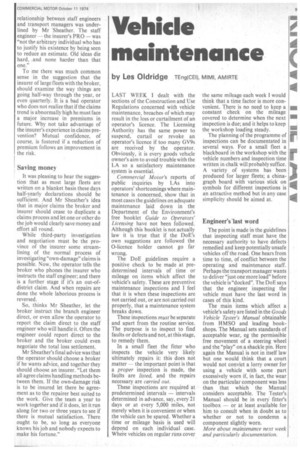Vehicle maintenance
Page 95

If you've noticed an error in this article please click here to report it so we can fix it.
by Les Oldridge TEng(CEI), MIMI, AMIRTE LAST WEEK I .dealt with the sections of the Construction and Use Regulations concerned with vehicle maintenance, breaches of which may result in the loss or curtailment of an operator's licence. The Licensing Authority has the same power to suspend, curtail or revoke an operator's licence if too many GV9s are received by the operator. Obviously, it is every goods vehicle owner's aim to avoid trouble with the LA so a satisfactory maintenance system is essential.
Commercial Motor's reports of public inquiries by LAs into operators' shortcomings where maintenance is concerned, show that in most cases the guidelines on adequate maintenance laid down in the Department of the Environment's free booklet Guide to Operators' Licensing have not been followed. Although this booklet is not actually law it is true that if the DoE's own suggestions are followed the 0-licence holder cannot go far wrong.
The DoE guidelines require a positive check to be made at predetermined intervals of time or mileage on items which affect the vehicle's safety. These are preventive maintenance inspections and I feel that it is when these inspections are not carried out, or are not carried out properly, that a maintenance system breaks down.
These inspections must be separate and apart from the routine service. The purpose is to inspect to find faults or defects and not, at this stage, to remedy them.
In a small fleet the fitter who inspects the vehicle very likely ultimately repairs it: this does not matter — the important point is that a proper inspection is made, the faults are listed, and the repairs necessary are carried out.
These inspections are required at predetermined intervals — intervals determined in advance, say, every 21 days or at every 5,000 miles, not merely when it is convenient or when the vehicle can be spared. Whether a time or mileage basis is used will depend on each individual case. Whei-e vehicles on regular runs cover the same mileage each week I would think that a time factor is more convenient. There is no need to keep a constant check on the mileage covered to determine when the next inspection is due; and it helps to keep the workshop loading steady.
The planning of the programme of inspections can be documentated in several ways. For a small fleet a blackboard in the workshop with the vehicle numbers and inspection time written in chalk will probably suffice. A variety of systems has been produced for larger fleets; a chinagraph board with various stick on symbols for different inspections is an attractive method but in any case simplicity should be aimed at.
Engineer's 'last word
The point is made in the guidelines that inspecting staff must have the necessary authority to have defects remedied and keep potentially unsafe vehicles off the road. One hears from time to time, of conflict between the operating and maintenance staff. Perhaps the transport manager wants to deliver "just one more load" before the vehicle is "docked". The DoE says that the engineer inspecting the vehicle must have the last word in cases of this kind.
The main items which affect a vehicle's safety are listed in the Goods Vehicle Tester's Manual obtainable from HMSO and leading bookshops. The Manual sets standards of acceptable wear, eg the permissible free movement of a steering wheel and the "play" on a shackle pin. Here again the Manual is not in itself law but one would think that a court would not convict a lorry owner for using a vehicle with some part excessively worn if, in fact, the wear on the particular component was less than that which the Manual considers acceptable. The Tester's Manual should be in every. fitter's toolbox — or at least available for him to consult when in doubt as to whether or not to condemn a component slightly worn.
More about maintenance next week and particularly documentation.




























































































































































